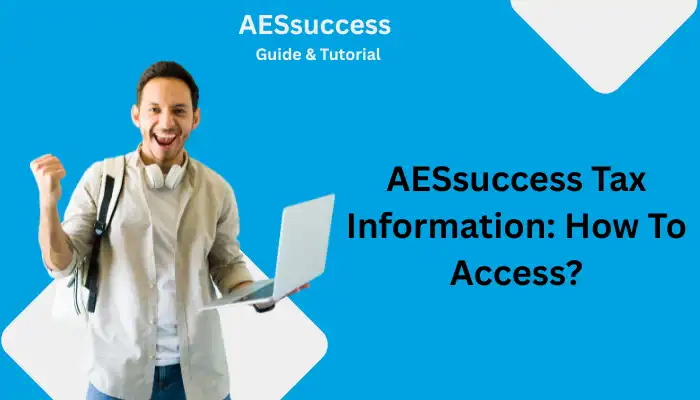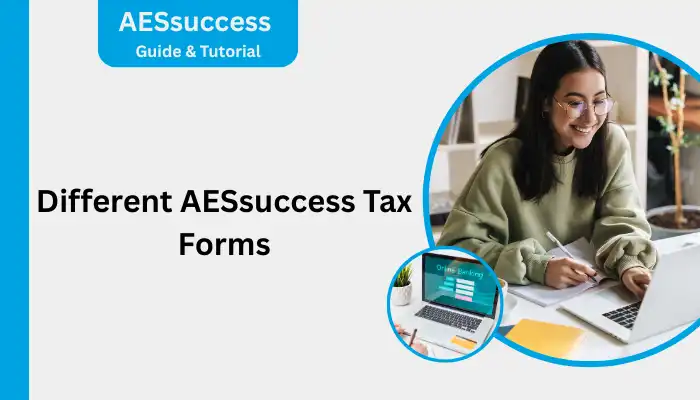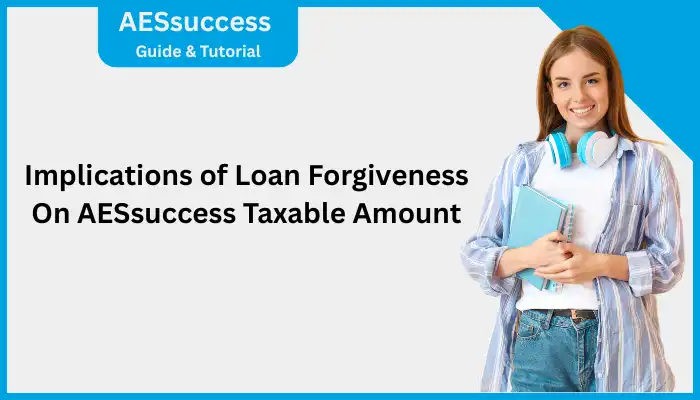Are you wondering how AESsuccess tax info can help you? This student loan tax guide demystifies the tax implications of your AES loans, covering forms, deductions, credits, forgiveness, and how to access your tax info. We’ll explore how to leverage your AESsuccess tax payment records to save money and keep the IRS happy.

Mastering these AES tax implications can boost your financial well-being and make tax season student loans less stressful. Ready to dive into this AESsuccess tax overview? Grab your AESsuccess login and let’s make navigating student loan taxes a breeze!

AESsuccess Tax Information: How To Access?
Getting your hands on your AESsuccess tax information is like finding the right key for a lock—it makes everything click.
This section will guide you through retrieving your tax info with clear steps, ensuring you’re fully prepared to use your AESsuccess tax payment data effectively.
Follow these steps to access your tax information on AESsuccess portal and stay on top of your tax prep:
Step 1: Log into Your AESsuccess Account:
Visit AESsuccess.org and use your AESsuccess account tax info portal to view and AESsuccess forms section to print forms like the 1098-E or 1099-C.
The portal is user-friendly and keeps everything digital, which I love for staying organized. Make sure your login credentials are handy—I keep mine in a password manager to avoid lockouts.
Step 2: Check for a Tax Summary Letter:
If your eligible interest is less than $600, you won’t get a 1098-E, but a Tax Summary letter is available in your AESsuccess tax documents portal.
This letter details your interest paid, which you can still deduct. I used this when I paid $400 in interest one year and still claimed the deduction—don’t miss this opportunity!
Step 3: Use the Automated Phone System (Optional):
If you can’t access the online portal, call AES’s automated system at 1-800-233-0557. You’ll need your account number, so have it ready. I’ve used this when my internet was down, and it worked well… for a while, until I went fully digital.
Step 4: Monitor Email Notifications:
AES emails your reportable interest amount to the email on file, including:
- Interest paid in the calendar year.
- Eligible Original Issue Discount (OID) satisfied by eligible principal paid.
- Eligible Capped Interest satisfied by eligible principal paid.
- Pro Tip: Update your email in your tax payment portal to ensure you get these notifications. I missed one once because my email was outdated—lesson learned!
Step 5: Choose Paperless or Mailed Forms:
If you paid or had debt canceled above the summed eligible amount (usually $600):
- Signed up for Paperless Tax: AES emails your tax form (e.g., 1098-E or 1099-C) by January 31. Going paperless decluttered my life—highly recommend!
- Not signed up for Paperless Tax: AES mails your form by January 31. Check your mailbox early to avoid delays, especially if you’re expecting a 1098-E.
Step 6: Seek Professional Help if Needed:
AES can’t advise on tax matters, so for questions, contact a tax professional or the IRS at 1-800-829-1040 or IRS.gov.
I always keep my tax payment records handy when talking to my accountant to ensure accuracy.
Now you’re a pro at accessing your AESsuccess tax info! Let’s tackle how to manage your tax information.
How To Manage AESsuccess Tax Payments?
Your tax payment history is like a financial diary that tells the story of your loan payments—and it’s a story that can save you money. I once almost missed a deduction because I didn’t check my records thoroughly.
This section will show you how to manage your AESsuccess payments for tax to ensure you’re maximizing deductions and staying organized.
Understanding Your Payment History
- How to View: Log into your tax payment history on AESsuccess.org. It breaks down principal and interest payments, with interest being key for your 1098-E.
- Why It Matters: Accurate records ensure your 1098-E is correct and maximize your student loan tax write-off. I check mine every January to prep for taxes.
- Tip: Download and save your payment history annually. It’s a lifesaver if you need to dispute a form. I keep mine in a “Tax Stuff” folder on my laptop.
Impact of Payment Plans
Your repayment plan—Standard, Graduated, or Income-Driven Repayment (IDR)—affects how much interest you pay, which directly impacts your 1098-E:
- Standard Plan: Fixed payments mean steady interest, often lower over time, which might reduce your deduction.
- Graduated Plan: Lower early payments mean more interest initially, boosting deductions in early years.
- IDR Plans: Lower payments can lead to higher interest over time, increasing your student loan tax write-off.
The plan itself doesn’t change your taxes, but the interest does. Choose a plan that aligns with your financial goals.
Important Dates
- 1098-E Availability: Available in your AESsuccess tax documents section.
- State Deadlines: Vary, so check state taxes and AES loans rules for your state.
Resolving Issues
- If your payment records don’t align with your 1098-E, contact AESsuccess customer service via their website or call center.
I had a payment misreported once, and a quick call to AES fixed it in days. Their support team is surprisingly helpful!
With your tax payments in order, you’re set to tackle tax season like a pro. Let’s answer some common questions next.

Different AESsuccess Tax Forms
Let’s kick things off with the paperwork that makes AESsuccess tax season tick—your tax forms. I remember the first time I got my 1098-E; it was like decoding a secret message that unlocked tax savings.
This section will walk you through the key documents you need and how to access them, ensuring you’re ready to tackle tax season student loans with confidence.
Form 1098-E: Student Loan Interest Statement
The 1098-E, or Student Loan Interest Statement, is your golden ticket to claiming the student loan interest deduction. This form reports the interest you paid on your AES student loan during the year, which can reduce your taxable income. You’ll receive it if you paid $600 or more in interest, but even smaller amounts qualify for deductions.
- How to Access It: Log into your AESsuccess account tax info portal at AESsuccess.org to download your 1098-E—it’s typically available by January 31. Prefer paper? AES mails it to your address on file, so ensure your contact info is updated. I learned this the hard way when a form got sent to my old apartment!
- What to Do With It: Use the interest amount reported on the 1098-E to claim your deduction on Schedule 1 of Form 1040. Your payment history is critical here—cross-check it to confirm the interest amount matches.
- Troubleshooting: No 1098-E? Check the AES tax form availability section online or contact AES support. If the amount seems wrong, compare it with your tax payment records. I once spotted a $50 discrepancy this way and got it corrected before filing.
While the 1098-E is the star, other forms might pop up in your AESsuccess tax journey, especially if your loan situation gets complex. I’ve had friends blindsided by unexpected forms, so let’s break down what else you might encounter and how to handle them.
Form 1099-C: Cancellation of Debt
This form appears if part of your AES loan is forgiven or discharged, such as through Borrower Defense to Repayment, Closed School Discharge, or certain settlements. It reports the forgiven amount as taxable income unless an exception applies (we’ll cover this in the forgiveness section).
For example, if $10,000 of your loan is forgiven, you’ll receive a 1099-C showing that amount, which could increase your tax bill unless it’s tax-free under programs like Public Service Loan Forgiveness (PSLF).
- How to Access It: Log into your AESsuccess account tax info portal at AESsuccess.org to download your 1099-C by January 31, if applicable. If you’re enrolled in Paperless Tax, AES emails it; otherwise, it’s mailed to your address on file. I had a friend who missed their 1099-C because they didn’t update their address—don’t let that be you!
- What to Do With It: Report the forgiven amount on your tax return (Form 1040, Line 7 for 2025) as taxable income, unless it qualifies for a tax-free exception (e.g., PSLF). Consult a tax professional to confirm taxability, especially if the amount seems significant. Your AESsuccess tax payment history can help verify the forgiven amount.
Check your tax documents portal for any forgiveness notices, and always verify the amount against your loan records. I had a friend who got a 1099-C and panicked, but a quick check confirmed it was tax-free—crisis averted!
That’s the lowdown on AESsuccess tax forms! With these in hand, you’re ready to move on to maximizing your savings.
AESsuccess Tax Benefits
Who doesn’t love a good tax break? When I first claimed the student loan interest deduction, it felt like finding a $20 bill in an old jacket—pure joy!
In this section, I’ll guide you through how to maximize your AESsuccess tax benefits with deductions and credits, using your AESsuccess tax payment data to claim every dollar you’re entitled to. Let’s dive into the details of tax strategies for student loans!
Student Loan Interest Deduction
The student loan interest deduction allows you to deduct up to $2,500 of interest paid on a qualified student loan. It’s an “above-the-line” deduction, meaning it reduces your taxable income before other deductions apply, which is a cool tip for lowering your tax bill.
- Eligibility:
- You’re legally obligated to pay interest on a student loan (e.g., your AES loan).
- You paid interest during the tax year—check your tax payment history for proof.
- Your filing status isn’t married filing separately.
- Your Modified Adjusted Gross Income (MAGI) is below $90,000 (single) or $185,000 (married filing jointly) in 2025. The deduction phases out above these limits.
- How It Works: Let’s say you paid $1,500 in interest (per your 1098-E). You can deduct that full amount, reducing your taxable income by $1,500. If you’re in the 22% tax bracket, that’s a $330 savings. I claimed $1,200 one year and felt like I’d won the tax lottery!
- How to Claim It: Enter the interest from your 1098-E on Schedule 1 (Form 1040), Line 21. Always verify the amount against your AESsuccess tax payment records to avoid errors.
Education Tax Credits
While not directly tied to loan payments, education tax credits are a vital part of your tax strategy if you’re still paying tuition or fees. These credits can significantly reduce your tax bill, but you need to know the rules.
American Opportunity Tax Credit (AOTC)
- Eligibility: Available for the first four years of higher education, you must be enrolled at least half-time in a degree program at an eligible institution.
- Benefit: Up to $2,500 per student, with 40% ($1,000) refundable—meaning you could get a refund even if you owe no taxes. I used AOTC during my undergrad years, and it covered my textbook costs one semester.
Lifetime Learning Credit (LLC)
- Eligibility: For undergraduate, graduate, or professional courses, with no limit on years of study. Great for part-time students or those upskilling.
- Benefit: Up to $2,000 per tax return (non-refundable, so it only offsets taxes owed).3.
You can’t claim both a credit and the student loan interest deduction for the same expenses, so strategize carefully. For example, if you paid $5,000 in tuition and $1,000 in loan interest, use AOTC for the tuition (up to $2,500) and the student loan interest deduction AES for the interest.
You’re now equipped to maximize your AESsuccess tax savings! Let’s move on to what happens when loans get forgiven.

Implications of Loan Forgiveness On AESsuccess Taxable Amount
Loan forgiveness sounds like a dream come true, but the tax implications can feel like a plot twist in a thriller. I had a friend who got a 1099-C and nearly fainted thinking they owed taxes on $20,000 of forgiven debt.
Let’s unpack the AESsuccess tax implications of forgiveness and how your AESsuccess tax payment records help you navigate student loan debt cancellation taxes.
More Taxable Income
Under IRS rules, forgiven or discharged debt is typically taxable income, reported on a Form 1099-C. For instance, if $15,000 of your loan is forgiven, that could add $15,000 to your taxable income, potentially bumping you into a higher tax bracket. This can sting if you’re not prepared.
Exceptions to the Rule
Thankfully, not all forgiveness is taxable, and recent laws have made things friendlier for borrowers:
- Income-Driven Repayment (IDR) Forgiveness: The American Rescue Plan Act of 2021 made most student loan forgiveness taxable-free through 2025. This is a huge relief for IDR borrowers, but it’s temporary, so keep an eye on updates post-2025. I know someone on an IDR plan who’s counting down to tax-free forgiveness—lucky them!
- Public Service Loan Forgiveness (PSLF): Always tax-free, making it a dream for teachers, nurses, or nonprofit workers. I know a teacher who hit PSLF and celebrated with a tax-free victory dance!
- Total and Permanent Disability (TPD) Discharge: Now tax-free due to legislative changes. Before 2018, this wasn’t always the case, so it’s a big win for those who qualify.
- Closed School Discharge and Borrower Defense to Repayment: Both are generally tax-free, protecting borrowers from predatory schools.
Handling a 1099-C
If you receive a 1099-C, don’t panic. Check your AESsuccess portal for any forgiveness notices, then consult a tax professional to confirm whether it’s taxable. I’ve seen folks assume it’s all taxable and overpay—don’t make that mistake! Your AESsuccess payment history can help clarify what’s been paid or forgiven.
AES may communicate forgiveness details through your AESsuccess account. Regularly review your tax payment history to track what’s been paid or forgiven, as this can impact your 1099-C or other forms. Staying proactive here is key.
Now you know the tax ins and outs of forgiveness—let’s talk about managing your payments for tax purposes.
Conclusion
Let’s wrap this up! Navigating AESsuccess tax doesn’t have to feel like solving a Rubik’s Cube in the dark. From accessing AES tax documents like the 1098-E to claiming the student loan interest deduction AES and understanding tax-free student loan discharge, you’ve got a comprehensive student loan tax guide at your fingertips.
Your AESsuccess tax payment records are your secret weapon—use them to verify deductions and stay informed about forgiveness. Log into your AESsuccess tax portal today to grab your forms, and don’t hesitate to consult a tax professional for tailored advice.
With this knowledge, you’re not just surviving tax season—you’re thriving. Here’s to empowering student loan borrowers and making AES tax next steps your victory lap!
